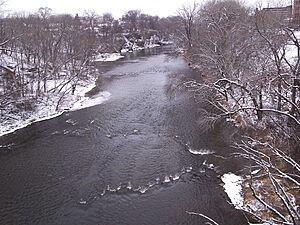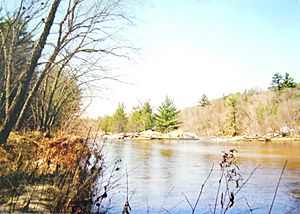Eau Claire River (Chippewa River tributary) facts for kids
The Eau Claire River is a cool river in west-central Wisconsin, USA. It flows into the Chippewa River. This river is special because its waters eventually join the huge Mississippi River. The name "Eau Claire" comes from French, meaning "Clear Water River." This name was inspired by the Ojibwe name, Wayaa-gonaatigweyaa-ziibi, which also means "Clear potable-water River."

Contents
Where the Eau Claire River Starts and Flows
The Eau Claire River actually begins as two smaller streams. These are called the North Fork Eau Claire River and the South Fork Eau Claire River. Both of these streams start in southwestern Taylor County.
The North and South Forks
The North Fork is about 25 miles (40 km) long. It flows past a village called Lublin. Another river, the Wolf River, joins the North Fork in Eau Claire County.
The South Fork is a bit longer, about 35 miles (56 km) long. Both forks flow southwest through Clark and Eau Claire Counties.
Journey to the Chippewa River
After the two forks meet, the main Eau Claire River flows west for about 40 miles (64 km). It passes by the city of Altoona. Finally, it joins the Chippewa River right in downtown Eau Claire.
Along its path, there are two dams. These dams create two large reservoirs (human-made lakes). These lakes are called Lake Eau Claire and Lake Altoona.
Big Falls Waterfall
Upstream from Altoona, near the village of Fall Creek, you can find a beautiful waterfall. It's known as Big Falls. This spot is also home to a fun county park where people can visit.
The River's History and Culture
The Eau Claire River has been important for a very long time. It played a role in agreements between different groups of people.
A Natural Boundary
In an 1825 treaty (a formal agreement), the Eau Claire River was used as a boundary. It helped mark the land between the Chippewa and Winnebago people.
Later, in an 1837 treaty, the river marked the southern edge of a special territory. In this area, the Ojibwe people were allowed to hunt, fish, and gather resources. This was important for them to keep their traditional way of life.


